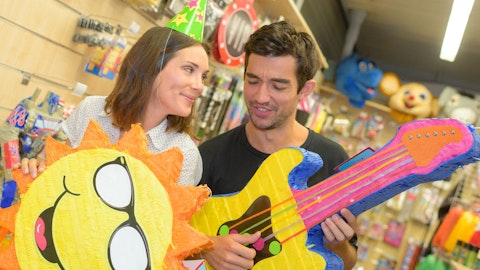JAKKS Pacific, Inc. (NASDAQ:JAKK) Q1 2024 Earnings Call Transcript April 24, 2024
JAKKS Pacific, Inc. misses on earnings expectations. Reported EPS is $-1.09 EPS, expectations were $-0.32. JAKK isn’t one of the 30 most popular stocks among hedge funds at the end of the third quarter (see the details here).
Operator: Good afternoon, everyone. Welcome to the JAKKS Pacific’s First Quarter 2024 Earnings Conference Call with management, who will review Financial Results for the quarter ended March 31, 2024. JAKKS issued its earnings press release earlier today. The earnings release and presentation slides related to today’s call are available on the company’s recently remodeled website in the Investor Section. On the call this afternoon are, Stephen Berman, Chairman and Chief Executive Officer; and John Kimble, Chief Financial Officer. Stephen will first provide an overview of the quarter along with highlights of recent performance and current business trends. Then John will provide some additional editorial around JAKKS Pacific’s financial and operational results.
Mr. Berman will then return with additional comments and some closing remarks prior to opening up the call for questions. If you would like to submit a question, e-mail it to investors@jakks.net. Before we begin, the company would like to point out that any comments made about JAKKS Pacific’s future performance, events or circumstances, including the estimates of sales, margins and/or adjusted EBITDA in 2024, as well as any other forward-looking statements concerning 2024 and beyond are subject to Safe Harbor protection under federal securities laws. These statements reflect the company’s best judgment based on current market trends and conditions today and are subject to certain risk uncertainties, which would cause actual results to differ materially from those projected in forward-looking statements.

For details concerning these and other such risk uncertainties, you should consult JAKKS’ most recent 10-K and 10-Q filings with the SEC, as well as the company’s other reports subsequently filed with the SEC from time to time. In addition, today’s comments by management will refer to non-GAAP financial measures, such as adjusted EBITDA and adjusted earnings per share. Unless stated otherwise, the most directly comparable GAAP financial metric has been reconciled to the associated non-GAAP financial measure within the company’s earnings press release issued today or previously. As a reminder, this conference is being recorded. With that, I would now like to turn the call over to Stephen Berman.
Stephen Berman: Good afternoon and thank you for joining us today. With our strong conviction, we are delighted with our current state of the business here at JAKKS. First, paying off our expensive and long-term debt last summer, and now retiring all the outstanding preferred shares. Our balance sheet has never been healthier. On the commercial side, I’ve personally been to Europe already twice this year, meeting with customers and licensors who are engaged about our renewed focus on those markets and excited to share their ideas to accelerate our growth there. And as we speak, we’ve had customers enter our showrooms for the last month, enthused about the current state of our portfolio and some of the new ideas we are chasing for 2025.
With that said, as our long-term investors know, first quarter is always our lowest shipping quarter. Retailers are cleaning up the shelves after the holiday season, and outside of the new entertainment-driven releases, it’s a time of year led by day in and day out sales in support of birthdays and other impulse-driven purchases. What you don’t see in the financial statements, but is of the highest importance during this time of year, is the table setting for the future business that I just talked about. Finalizing commitments against promotional opportunities and retail placement for later in the year happens now. Discussions about new listings for spring and even fall 2025 are happening now. And for us in particular, conversations about new entertainment releases and new product initiatives for 2025 and even 2026 are happening as well.
See also 15 Best Places to Retire in Rhode Island and 10 Stocks Hedge Funds Are Talking About.
Q&A Session
Follow Jakks Pacific Inc (NASDAQ:JAKK)
Follow Jakks Pacific Inc (NASDAQ:JAKK)
Through that lens, the first quarter has gone well for us at JAKKS, even if the financial results are less than thrilling. Our revenues were in line with our expectations, given the absence of new films in our first half portfolio. Unfortunately, despite lowering our expectations for the additional shipments in support of a key Q4 2023 film, the reality is its release via streaming has done little to improve what has been a real disappointment for all involved. We continue to be an FOB-first company. In 2023, over 70% of our total company sales were made FOB out of Asia. Although this allows us to operate with leaner inventory and working capital than other companies in our space, it nonetheless means we are not immune to inventory write-down issues when results significantly deviate from expectations as was the case with the aforementioned film.
We’re always operating in three different years at the same time in our industry. Shipping to customers who are selling through to consumers daily, previewing 2025 product to retailers behind closed doors, and brainstorming new initiatives and opportunities internally and externally that might be 18 to 24 months away from ultimately shipping. That reality is in conflict to the quarterly reports of results in a business with our seasonality. And with that in mind, we know that SG&A in the lighter quarters are going to look heavier from time to time. We have talked about increased spending on infrastructure, and we continue to do that in a thoughtful way, evaluating our full-year profit and cash-generating targets. The efforts we’re making today in areas like European and Mexico distribution capabilities, demand creation, and related tech support are the right things to do for our company.
I am confident when we get into 2025 and 2026, we will be even happier about the progress we’re seeing today, even acknowledging it’s not a straight line to success, and there’s a degree of test and learn in most of these things that we do. Finally, I want to talk a bit about the redemption of our preferred shares. When the company was recapitalized in 2019, we were in a very difficult situation as the bankruptcy of Toys R Us and other important customers in the preceding years sent a shockwave through our industry and significantly changed the market dynamics that we had been operating under in the decades plus previously. Since the recapitalization, we have been clear in our goals to tighten the focus around our core business, improve our margins, and unencumber our balance sheet.
The team’s collective efforts, as well as the collaborative success with our business partners, has allowed us to exceed nearly every expectation over the following five years. We refinanced our debt in the middle of 2021, paid off that balance in 2023, and now finally have retired the last artifact of that restructuring. The preferred shares required us to accrue or pay quarterly dividend and prohibited us any return of capital to the common shareholder base. Although the negotiated settlement used up over half our cash on hand as we headed into a tight liquidity season, the board and I felt the right decision to make was to take the opportunity to repurchase those shares at a discount to their contractually entitled pricing when that opportunity presented itself.
A company of our size has always had to be mindful of unanticipated market disruptions and the potential impact on our results and liquidity, and it is my highest priority personally to ensure that we are future-proofing the company as best as we can to avoid the situation we found ourselves in back in 2019. As the preferred opportunities surface somewhat unexpectedly, we are not in a position today to articulate precisely what’s next, given what we’ve achieved in our aforementioned goals as it relates to a clean balance sheet. The board and I are discussing a number of considerations, and John will touch upon the topic a bit, but I wanted to point out that we are mindful that investors’ community is understandably curious as to where we think we are headed given our remarkable accomplishments in this area.
At least in our opinion. And with that, I will pass it over to John.
John Kimble: Thank you, Stephen, and hi, everybody. First quarter results are never a particularly interesting topic from a financial perspective. Over the past four to five years, our Q1 revenues have never represented more than 15% of our full-year results, which is not a great starting point when looking at most P&L metrics. Nonetheless, as we are always on the lookout for ways to add transparency to our business while being mindful of the confidentiality of data with respect to our partners, I wanted to highlight some increased disclosures we have made in the presentation deck that we include along with our earnings releases. You’ve heard us talk about our core business of evergreen brands, categories, and play patterns, but investors who are less familiar with the toy space are sometimes challenged to understand the combination of our core evergreen business and the additional product lines enabled by new entertainment.
Our daily objective is expanding those core evergreen product lines into more points of distribution and deeper buys, but our existence adjacent to the entertainment and gaming industries occasionally provides us with another lever to pull for more volume and margin on top of that core business. For recent years, our published financial data disclosed net sales organized by four operating divisions, action play and collectibles, dolls, role play, and dress up, outdoor seasonal toys and consumer products, and our costume business. And we will continue to share those results going forward. But as we’ve crunched the numbers more and discussed internally, it’s the latter two businesses, seasonal and costumes, which we have concluded are somewhat less sensitive to new entertainment.
Unless someone makes a movie about Ball Pits, we’re generally going to sell a certain number of Ball Pits every year. And what drives the number is more individual retailers tweaking their dedicated shelf space and/or our portion of that space more than entertainment driving more per capita consumption. As support for that argument, I’ll point out how the seasonal business has struggled in recent years as the larger cube footprint of a lot of the items suffered through high container costs, inventory backups, and retailers taking a more critical view of allocating floor space to those items, especially after selling a lot of them during COVID. The costumes business similarly is trying to find its footing in a post COVID world as 2020, 2021, 2022, have probably been the most unpredictable years in the business for a really long time.
But on the flip side, it’s the action figures and doll business where the new entertainment will generate an entirely new product line of anywhere from six to a couple dozen unique SKUs, as opposed to one or two new Ball Pits taking the place of last year’s Ball Pits. And those new product ranges will get dedicated shelf space for a season or two or end cap placement or out of aisle pallets or all of the above. Retailers who only carry toys for a portion of the year will be looking to stock these hottest on-trend properties. And that’s the lift that the right entertainment releases can generate. So informed by that understanding of the business, we went back and essentially recut the two divisions that we’ve been disclosing previously and created an alternate view of them to provide you with a better understanding of how the underlying business is performing.



